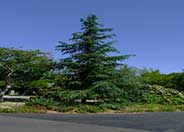
Common name:Deodar Cedar
Botanical name:Cedrus deodara
Deodar Cedar (Cedrus deodara) is a large, upright, evergreen tree that can mature to 60' tall and 30' wide. When this plant is small in the nursery, it has a nearly perfect Christmas tree shape with weeping branches, making it appear to be a perfect specimen for a small garden. It will quickly outgrow small garden spaces, so it is best to select this specimen tree only when you have a larger garden. This tree is often used in parks and large open spaces due to its size and natural upright habit. If this tree is planted in a location where it can reach its mature size, it will require almost no pruning or fertilizer. However, if it is planted in a location that is too small, a licensed arborist should be hired to maintain it. This tree should be planted at least 10 feet away from any hardscape areas, 20 feet from structures such as houses and buildings, and not near any powerlines. Shrubs and perennials should be planted about five feet away from this tree. It should be irrigated for about 45 minutes once a week when using most in-line drip irrigation systems.
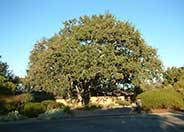
Common name:Coast Live Oak
Botanical name:Quercus agrifolia
Coast Live Oak (Quercus agrifolia) is one of the best trees for California native or California-friendly gardens. It grows very well from the coastal areas to the interior valleys. It is an evergreen tree that can reach 25’-70' tall and up to 70' wide, so make sure you have the space in your garden to support it. It is considered very low-water-use and is susceptible to root rot in gardens that are over-irrigated. Plant it with other California natives or low-water plants and stick to a watering cycle that includes watering during the fall, winter, and spring with no supplemental water in the summer. The tree is a slow grower and has an irregular shape when it is young, so it is important to make minimal pruning cuts to improve the look of the canopy. Over-pruning or hedging can take years to recover from, so consult or hire a licensed arborist when the shaping becomes out of your reach. This tree will eventually become a large shade tree; therefore, the plant selection around it may need to be adjusted as it matures. This tree should be planted at least five feet away from any hardscape areas, 20 feet from structures such as houses and buildings, and not near any powerlines. Shrubs and perennials should be planted about four feet away from this tree. It should be irrigated for about 45 minutes once a week when using most in-line drip irrigation systems.
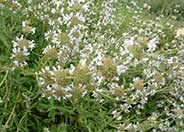
Common name:Black Sage
Botanical name:Salvia mellifera
This woody shrub has fragrant, dark green leaves with blue, white, or lilac flowers that bloom in the spring and summer.
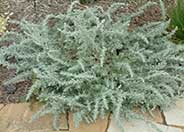
Common name:Sandhill Sage, Coast Sagebrush
Botanical name:Artemisia pycnocephala
This shrub will grow anywhere from 1'-3' tall and has small gray leaves accented by yellow flowers that bloom in spring.
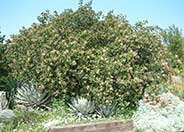
Common name:Sugar Bush
Botanical name:Rhus ovata
This dense, rounded evergreen shrub grows 8'-15' tall and wide, with creamy flowers between March and May. The shrub bears small red fruit. It grows well in inland areas and is drought tolerant. The foliage is leathery and rich looking and dark green in color. It needs additional water in low desert areas every 2 weeks or plant in area with afternoon shade. It needs a well drained site. It is susceptible to verticillium wilt in wet areas.
Photographer: GardenSoft
Maintain a two to four inch layer of mulch on the soil surface to reduce weeds, infiltrate rain water, and reduce compaction.
Be sure to fix all leaks promptly no matter how small they may seem.
Develop healthy soil for plants that are vigorous and naturally pest-resistant.